Fascinating simplicity. The varieties of roses with simple flower. Botanic, ancient and modern roses, which share the same 5 petal structure of the flower.
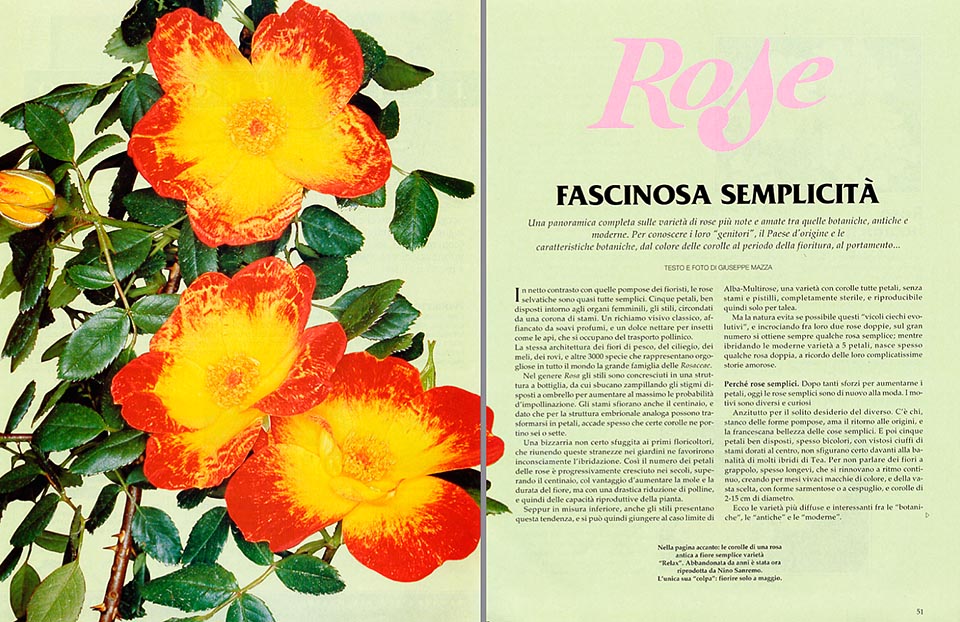
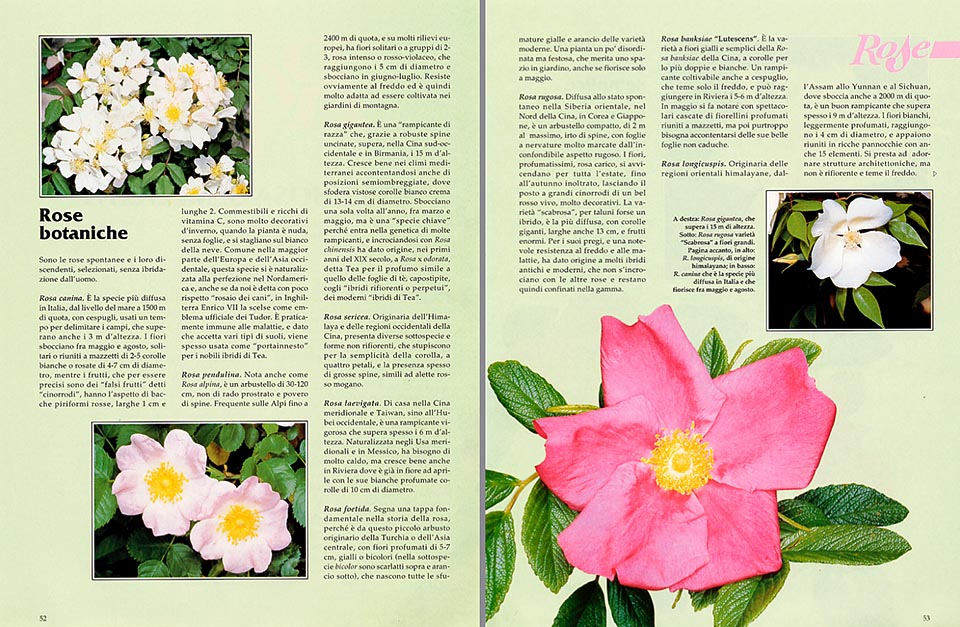
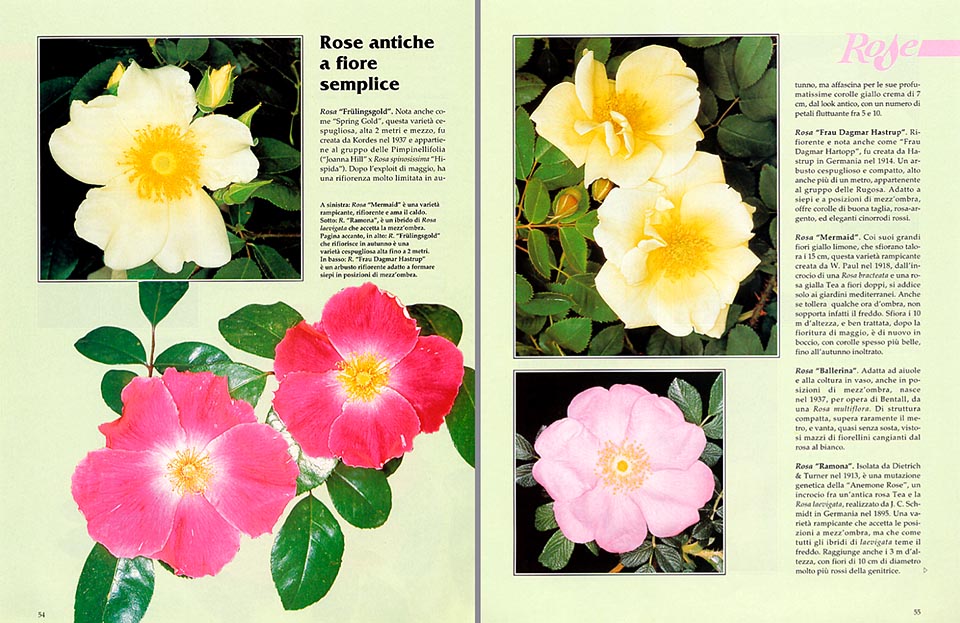
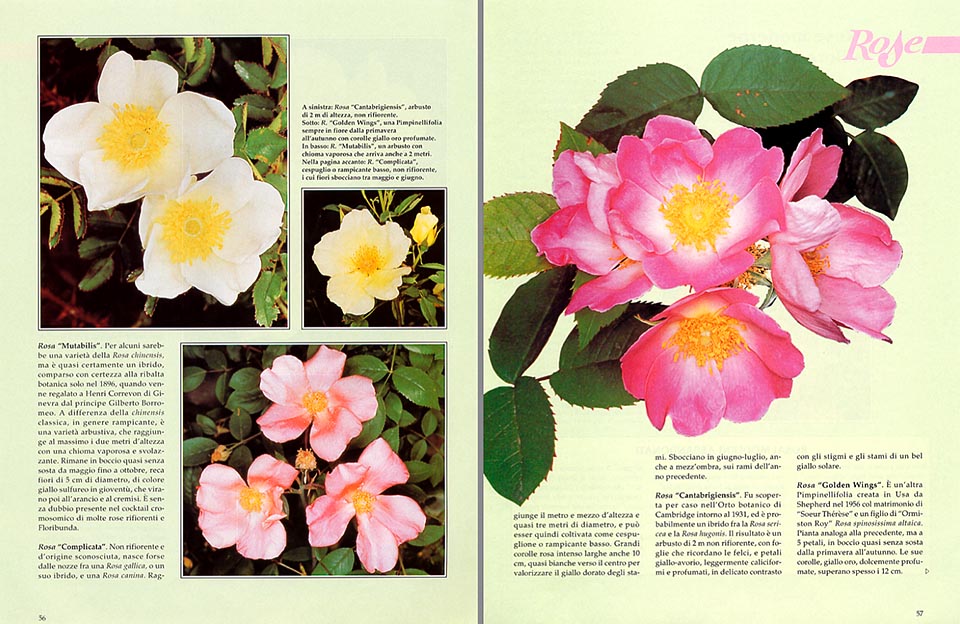
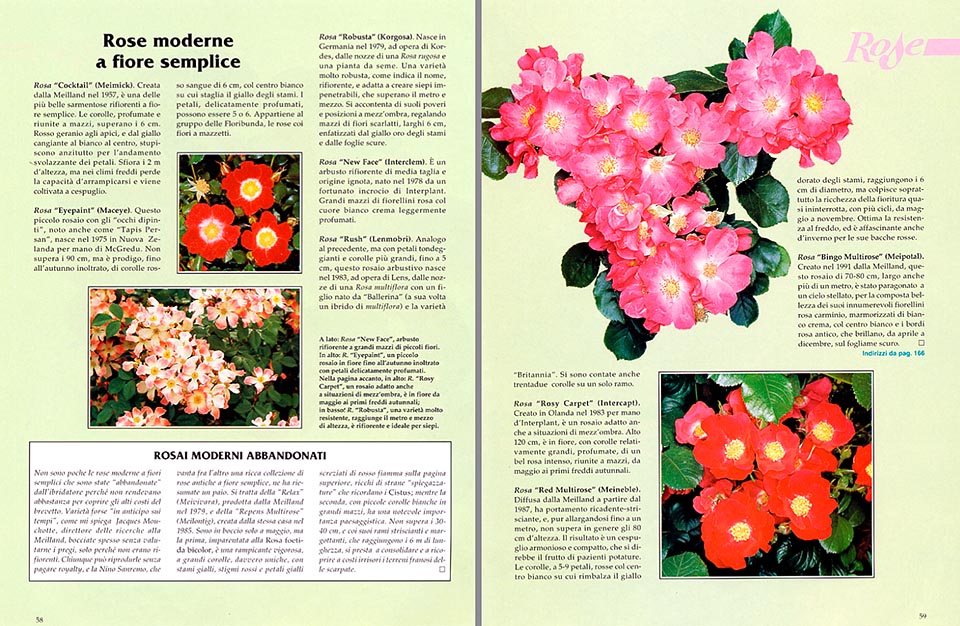

Texto © Giuseppe Mazza

English translation by Mario Beltramini
Wild roses are, almost always, simple, in evident contrast with the pompous ones of the florists.
Five petals, well placed around the feminine organs, the styles, surrounded by a crown of stamens. A classical visual call, accompanied by gentle perfumes and sweet nectar for insects like the bees, which take care of the transportation of the pollen.
The same architecture as the flowers of the peach-tree, the cherry-tree, the apple-trees, the brambles, and other 3.000 species, which represent, proudly, in the whole world, the big family of the Rosaceae.
In the genus Rosa, the styles are concrescences in a bottle-like structure, from which come out, gushing, the stigmata placed like an umbrella in order to increase at the maximum extent the probabilities of pollination.
The stamens are almost one hundred, and as, due to the analogous embryonal structure, they can transform in petals, it happens often that some corollas carry 6 or 7 of them.
A strangeness which, by sure, was noticed by the first floriculturists, who, gathering these oddities in the gardens, did, unconsciously, foster their hybridization.
So, the number of the petals of the roses has progressively increased during the centuries, overcoming the hundred, with the advantage of increasing the size and the duration of the flower, but with a drastic reduction of pollen, and therefore of the reproductive capacities of the plant.
Even if in an inferior extent, also the styles present this trend, and we can, therefore, reach the limit of the Alba-Multirose, a variety with corollas full of petals, without stamens and pistils, completely sterile, and reproducible, therefore, only by cutting.
But the nature shuns, if possible, these “blind evolution alleys”, and crossing between them two double roses, through the quantity, we always get some simple rose; whilst hybridizing the modern 5 petals varieties, it often comes out some double rose, as a souvenir of their extremely complicated love stories.
WHY SIMPLE ROSES
After many efforts for increasing their petals, now the simple roses are again in fashion. Why?
First of all, for the usual wish of the different. There is who, that, tired of the pompous forms, loves the return to the origins, and the Franciscan beauty of the simple things. And then, five petals well placed, often two-coloured, with showy tufts of stamens, golden at the centre, do not by sure , cut a poor figure in front of the banality of many hybrids of Tea.
Not to talk about cluster flowers, often long-lived, which renew incessantly, creating for months lively spots of colour, and of the ample choice, with sarmentose or bushy forms, and 2-15 cm diameter corollas.
Here are the most common and interesting varieties of the “botanical”, the “ancient”, and the “modern” ones.
BOTANICAL ROSES
They are the spontaneous roses and their descendants, selected, without hybridization done by man.
It is the most propagated species in Italy, from the sea level up to an altitude of 1.500 metres, with bushes, used time ago for circumscribing the fields, which even overcome the three metres of height. The flowers blossom between May and August, solitary, or united in small bunches of 2-5 white or rosy corollas of 4-7 cm of diameter, while the fruits, which, to be accurate are “false fruits”, called “dragon’s eyes”, have the look of red pyriform berries, 1 cm wide and 2 long. Edible and rich of vitamin C, they are very ornamental in winter, when the plant is bare, without leaves, and shows up on the whiteness of the snow. Common in most parts of Europe and western Asia, this species has naturalized perfectly in North America, and even if in our country is called, disrespectfully, “rose-bush of the dogs”, in England, Henry VII chose it as official emblem of the Tudors. It is practically exempt from diseases, and since it accept several types of soil, is often used as “graft carrier” for the noble hybrids of Tea.
ROSA PENDULINA
Known also as Alpine Rose, is a small shrub of 30-120 cm, frequently prostrate and poor of thorns. Common in the Alps up to 2.400 metres of altitude, and in many European heights, has solitary flowers, or by groups of 2-3, intense pink or purple-red, which reach the 5 cm of diameter, and blossom in June-July. Obviously, it resists to the cold and is therefore very suitable for mountain gardens.
It is a “climbing of breed”, which, thanks to robust hooked thorns, overcomes, in South-western China and Myanmar, the 15 metres of height. It grows up well in the Mediterranean climates, contenting itself also of half-shaded positions, where it exhibits showy white-cream corollas of 13-14 cm of diameter. They blossom only once a year, between March and May, but it is a “key species” in the history of the roses, because is present in the genetics of many climbing roses, and crossing with the Rosa chinensis, has originated, during the first years of the nineteenth century, to the mythical Rosa x odorata, called Tea, for the perfume similar to that of the leaves of tea, founder, with the “re-flowering, or perennial hybrids”, of the modern “hybrids of Tea”.
ROSA SERICEA
Native to Himalaya and the western regions of China, presents several sub-species and not-re-flowering species, which astonish for the simplicity of the corolla, with four petals, and the frequent presence of big thorns, resembling to mahogany red small wings.
At home in Southern China and Taiwan, till Western Hubei, is a vigorous climber, which often overcomes the 6 metres of height. Naturalized in Southern USA and Mexico, needs much heat, but grows up well also in the Riviera, where is already blooming in April, with its white perfumed corollas with a diameter of 10 cm.
It is a fundamental step in the history of the roses, because it is from this small shrub native to Turkey or central Asia, with perfumed flowers of 5-7 cm, yellow or two-coloured (in the sub- species bicolor, they are scarlet on the upper side and orange on the inferior one), which come all the yellow and orange gradations of the modern varieties. A rather muddled, but gay plant, which deserves some room in the garden, even if it blossoms only in May.
Spread at the spontaneous state in Eastern Siberia, North China, Korea and Japan, it’s a small compact shrub, tall 2 metres at the most, full of thorns, with leaves and nervations very evident with the unmistakable wrinkled appearance. The flowers, much perfumed, deep pink, alternate all the summer long, till late in autumn, leave the place to big, bright red, berries, very ornamental. The form “scabrosa”, for somebody perhaps a hybrid, is the most common, with gigantic corollas, even 13 cm wide, and enormous fruits. For its merits, and a remarkable resistance to the cold and the diseases, has originated many ancient and modern hybrids, which do not cross with the other roses and therefore remain confined in the gamut.
It is the variety with yellow and simple flowers of the Rosa Banksiae of China, with corollas mostly double and white. A climber which can be cultivated also as shrub, which fears only the cold, and can reach a height, in Riviera, of 5-6 metres. In May, it is noticed for the spectacular cascades of little perfumed flowers, united in small bunches, but then, later on, we have to content ourselves of its nice non-deciduous leaves.
Native to the eastern Himalayan areas, Assam, Yunnan and Sichuan, where it blooms even at 2.000 metres of altitude, is a good climber which often overcomes the 9 metres of height. The white, slightly perfumed, flowers, reach the diameter of 4 cm, and appear united in rich panicles with even 15 elements. Suitable for adorning various architectural structures, such as the iron fences and front gates of the villas, but not re-flowering, and fearing the cold.
ANCIENT ROSES WITH SIMPLE FLOWER
For some, it should be a variety of the Rosa Chinensis, but is, almost certainly, a hybrid, appeared, by sure, on the British stage only in 1896, when it was given, as a present, to Henri Correvon of Geneva, by the Prince Gilberto Borromeo. Unlike the classical chinensis, normally climbing, it is a shrubby variety, which reaches, at the most, the two metres of height, with a flimsy and fluttering head of hair. In bud, almost continuously, from May to October, carries 5 cm diameter flowers, sulphur yellow, when young, which change later on to orange and crimson. It is, without any doubt, present in the chromosomic cocktail of many re-flowering and “Floribunda” roses.
Not re-flowering and of unknown origin, born, perhaps, from the marriage between a Rosa gallica, or one of its hybrids, and a Rosa canina. It reaches, with its long bent branches, the metre and a half of height, and almost three of diameter, and consequently can be cultivated also as a big bush or as a low climber. Huge corollas, intense pink, wide even 10 cm, almost white towards the centre, for exhibiting the gold yellow of the stamens. They blossom in June-July, also in mid-shade, on the previous years branches.
ROSA ‘CANTABRIGIENSIS’
Discovered by chance in the Botanical Garden of Cambridge, around 1931, is probably a hybrid between the Rosa sericea hookeri and the Rosa hugonis. The result is a bush of 2 metres, not re-flowering, with leaves which recall the ferns, and petals ivory-yellow, slightly calyx-shaped and perfumed, in delicate contrast with the stigmata and the nice sunny yellow stamens.
Known also as Spring Gold, this bushy variety, 2 metres and a half tall, was created by Kondes in 1937 and belongs to the groups of the Pimpinefollia (Joanna Hill x Rosa spinosissima hispida). After the May exploit, has a very limited new flowering in autumn, but it bewitches for its very perfumed cream yellow corollas of 7 cm, with an old look, and a number of petals varying from 5 to 10. It tolerates also the mid-shade positions.
It is another Pimpinefollia created in USA by Shepherd in 1956, with the marriage of Soeur Thérèse and a son of Ormiston Roy x Rosa spinosissima altaica. Plant similar to the previous one, but with 5 petals, in bud, almost continuously, from spring to autumn. Its corollas, gold-yellow, sweetly perfumed, often overcome the 12 cm.
Re-flowering and known also as Frau Dagmar Hartopp, was created by Hastrup, in Germany, in 1914. A shrubby and compact bush, tall even more than one metre, belonging to the group of the “Rugosa”. Suitable for hedges and mid-shade locations, offers corollas of good size, silver-pink, and elegant red berries, resembling to tomatoes.
ROSA ‘MERMAID’
With its big, almost 15 cm, lemon-yellow flowers, this climbing variety created by W. Paul in 1918, from the cross breeding of a Rosa bracteata and a yellow Tea rose with double flowers, is fit only for the Mediterranean gardens. Even if it tolerates few hours in the shade, it does not bear, in fact, the cold. It reaches almost the 10 metres of height, and if well cared, after the May flowering, will be again in bud, often with even nicer corollas, till late in autumn.
ROSA ‘BALLERINA’
Suitable for flower-beds and for the cultivation in pot, also in mid-shade positions, it was born in 1937, by means of Bentall, from a Rosa multiflora. With a compact structure, seldom taller than one metre, and exhibits, almost incessantly, showy bunches of little flowers changing from the pink to the white.
ROSA ‘RAMONA’
Isolated by Dietrich & Turner in 1913, is a genetic mutation of the Anemone Rose, a cross between an old rose Tea and the Rosa laevigata, realized by J.C. Schmidt in Germany, in 1895. A climbing variety which accepts mid-shade positions, but which, like all hybrids of laevigata, fears the cold. It reaches even the 3 metres of height, with flowers of 10 cm of diameter, much more red-coloured than the mother.
MODERN ROSES WITH SIMPLE FLOWER
ROSA ‘COCKTAIL’ (Meimick)
Created by Meilland in 1957, is one of the nicest re-flowering sarmentose with simple flower. The corollas, perfumed and united in bunches, overcome the 6 cm. Geranium-red on the apexes, and yellow, changing to white, in the centre, they astonish, first of all, for the fluttering movement of the petals. It’s almost 2 metres tall, but in the cold climates it loses the capacity of climbing and is then cultivated as bush.
ROSA ‘EYEPAINT’ (Maceye)
This small rose-bush with “painted eyes”, also known as “Tapis Persan”, was born in 1975 in New Zealand by means of McGredy. Not taller more than 90 cm, but prodigal, till late in autumn, of blood-red corollas of 6 cm, with the white centre on which stands out the yellow of the stamens. The petals, gently perfumed, can be 5 or 6. It belongs to the group of the “Floribunda”, the well known roses with flowers in small bunches.
ROSA ‘ROBUSTA’ (Korgosa)
Born in Germany, in 1979, by means of Kordes, from the wedding of a Rosa rugosa and a seed plant. A very robust variety, as the name suggests, re-flowering, and suitable for creating impenetrable hedges, taller than a metre and a half. It contents of poor soils and of mid-shaded locations, producing bunches of scarlet flowers, 6 cm wide, emphasized by the gold yellow of the stamens and by the dark leaves.
ROSA ‘NEW FACE’ (Interclem)
It is a re-flowering shrub of average size and of unknown origin, born in 1978, from a lucky cross breeding of Interplant. Great bunches of little pink flowers, with cream-white heart, slightly perfumed.
ROSA ‘RUSH’ (Lenmobri)
Similar to the previous one, but with roundish petals and greater corollas, up to 5 cm, this shrubby rose was born in 1983, by means of Lens, from the marriage of a Rosa multiflora with a son born from Ballerina (in its turn, a hybrid of multiflora), and the variety Britannia. They have counted even 32 corollas on one branch.
ROSA ‘ROSY CARPET’ (Intercarp)
Created in Holland in 1983, by Interplant, is a rose-bush suitable also for mid-shade positions. 120 cm tall, is in flower, with rather large corollas, perfumed, of a nice, intense, pink, united in bunches, from May till the first autumn colds.
ROSA ‘RED MEIDILAND’ (Meineble)
Diffused by Meilland since 1987, has a hanging-crawling aspect, and even if widening up to one metre, usually it does not overcome the 80 cm of height. The outcome is a shrub, harmonious and compact, which could be thought to be the result of patient pruning. The 5-9 petals corollas, red with white centre, on which stands out the gold yellow of the stamens, reach the 6 cm of diameter, but what is mostly striking is the richness of the flowering, almost uninterrupted, with several cycles, from May to November. Very good resistance to the cold, and also in winter, between the snow, it is fascinating for its small red berries.
ROSA ‘BINGO MEIDILAND’ (Meipotal)
Created in 1991 by Meilland, this rose-bush of 70-80 cm, wide even more than one metre, has been compared to a starry sky, for the tidy beauty of its countless carmine pink small flowers, marbled of cream-white, with white centre and old-pink borders, which shine, from April to December, on the dark foliage.
MODERN ABANDONED ROSE-BUSHES
There are several modern roses with simple flowers, which have been “abandoned” by the hybridizer, because they were not repaying sufficiently for covering the high costs of the patent.
Varieties maybe “in advance on the times”, as Jacques Mouchotte, director of the researches at Meilland’s, explains to me, rejected often without evaluating their qualities, only because they will not be re-flowering.
Anyone can reproduce them without paying any royalty, and the NINO SANREMO, which boasts, among other things, a rich collection of ancient simple flower roses, has exhumed a couple of them.
They are the Relax (Meivivara), produced by Meilland in 1979, and the Repens Multirose (Meilontig), created by the same Firm in 1985.
They are in bud only in May, but the first one, relative to the Rosa foetida bicolor, is a vigorous climbing, with great corollas, really unique, with yellow stamens, red stigmata, and yellow petals, variegated of blazing red on the upper side, rich of odd “crumples”, which recall the Cistus; whilst the second one, with small white corollas on great bunches has a remarkable landscape importance. It does not overcome the 30-40 cm, and with its crawling and layering branches, which can be 6 metres long, is suitable for consolidating and recovering, at low costs, the slipping down soils of the escarpments.
GARDENIA – 1994
→ History of the rose : from the Wild Roses towards a perfect rose.
→ To appreciate the biodiversity of roses, please click here.
